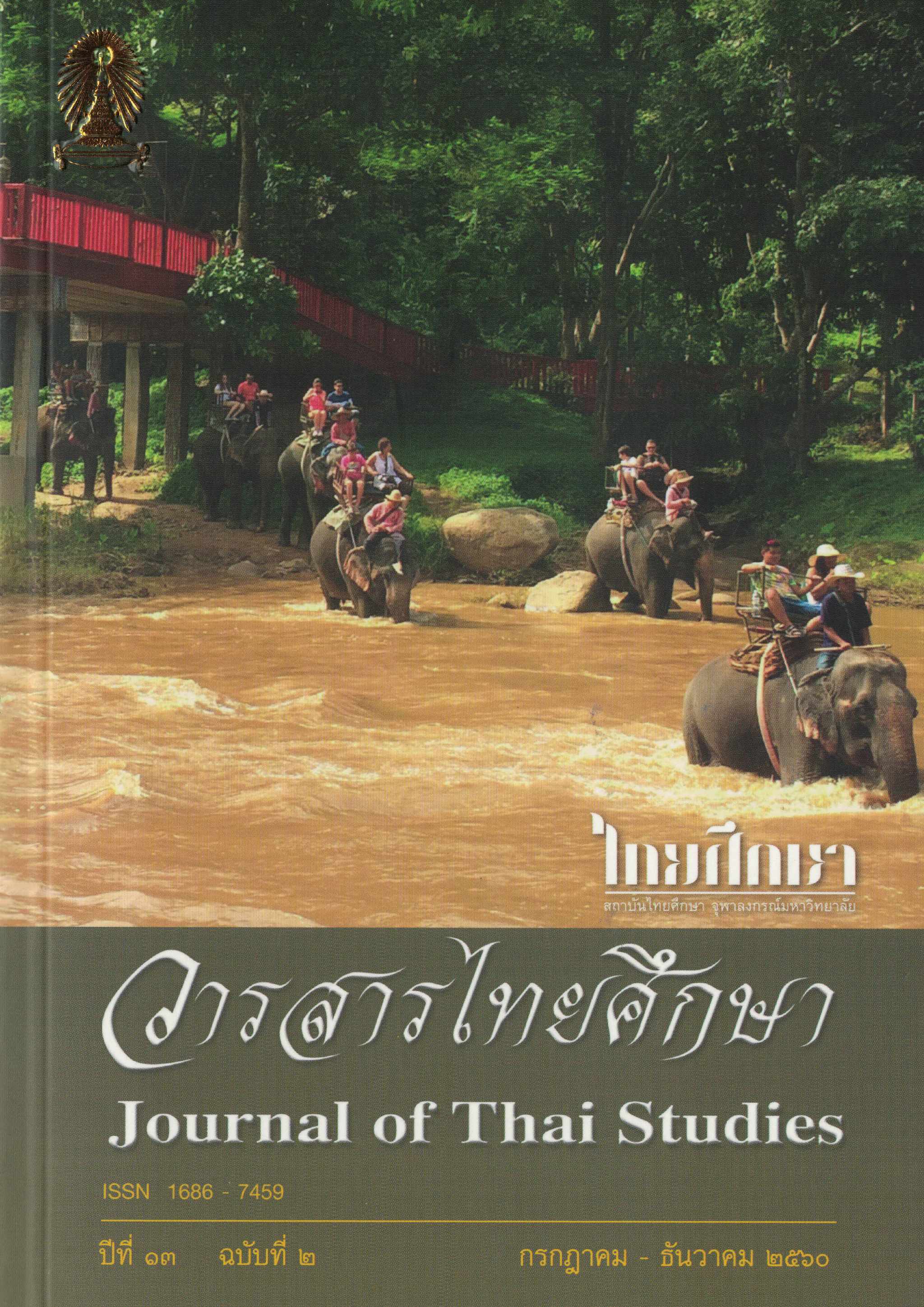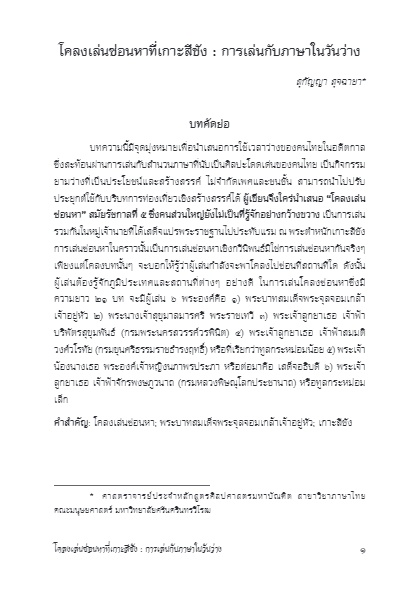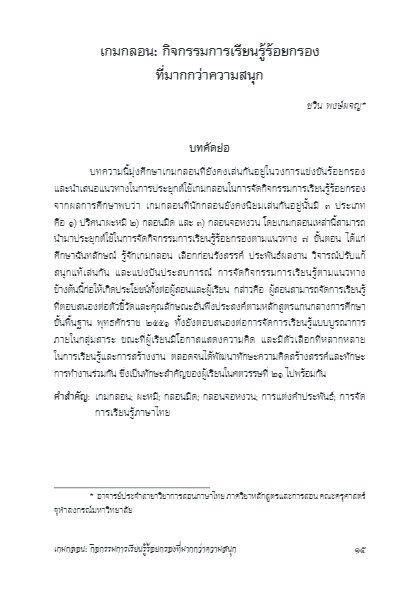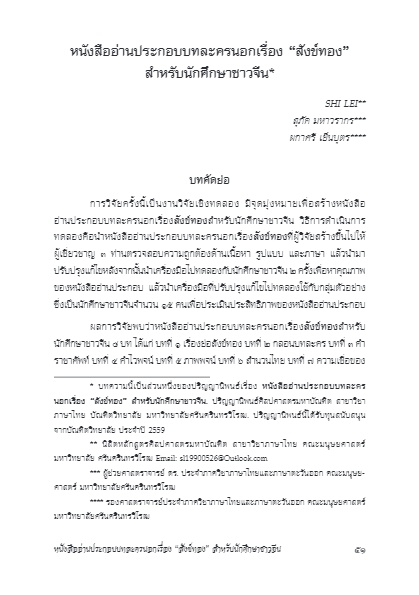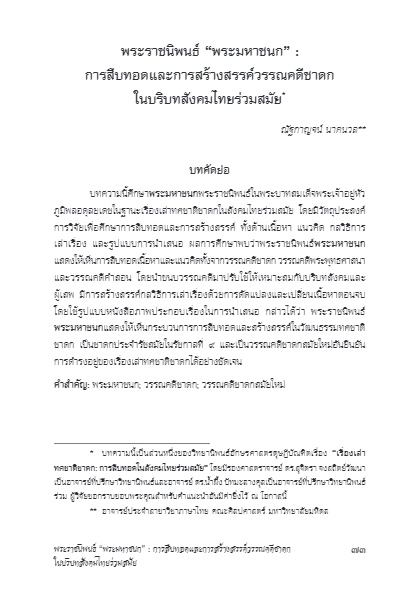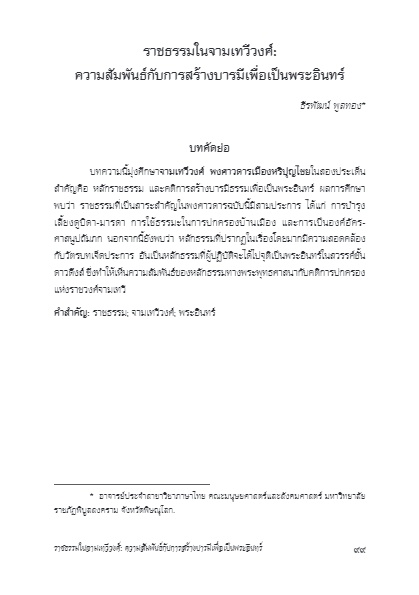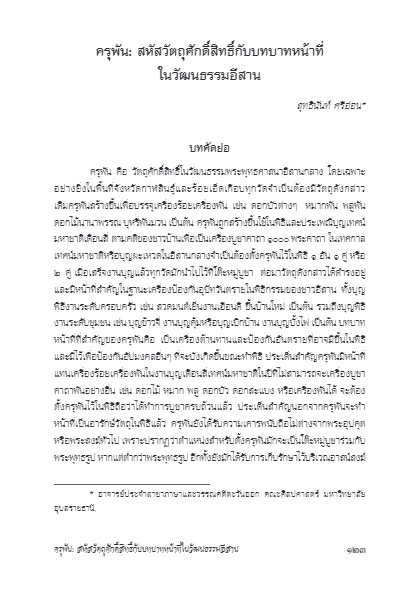วารสารไทยศึกษา - ปีที่ 13 ฉบับที่ 2

1) โคลงเล่นซ่อนหาที่เกาะสีชัง : การเล่นกับภาษาในวันว่าง / สุกัญญา สุจฉายา
2) เกมกลอน : กิจกรรมการเรียนรู้ร้อยกรองที่มากกว่าความสนุก / ชวิน พงษ์ผจญ
3) หนังสืออ่านประกอบละครนอกเรื่อง “สังข์ทอง” สำหรับนักศึกษาชาวจีน / SHI LEI, สุภัค มหาวรากร, ผกาศรี เย็นบุตร
4) พระราชนิพนธ์ “พระมหาชนก” : การสืบทอดและการสร้างสรรค์วรรณคดีชาดกในบริบทสังคมไทยร่วมสมัย / ณัฐกาญจน์ นาคนวล
5) ราชธรรมในจามเทวีวงศ์ : ความสัมพันธ์กับการสร้างบารมีเพื่อเป็นพระอินทร์ / ธีรพัฒน์ พูลทอง
6) ครุพัน : สหัสวัตถุศักดิ์สิทธิ์กับบทบาทหน้าที่ในวัฒนธรรมอีสาน / สุทธินันท์ ศรีอ่อน
7) ประเพณีแซนโฎนตาบูชาบรรพบุรุษ: บทบาทประเพณีที่มีต่อชาวสุรินทร์ในปัจจุบัน / สารภี ขาวดี
โคลงเล่นซ่อนหาที่เกาะสีชัง : การเล่นกับภาษาในวันว่าง
สุกัญญา สุจฉายา
บทคัดย่อ
บทความนี้มีจุดมุ่งหมายเพื่อนำเสนอการใช้เวลาว่างของคนไทยในอดีตกาล ซึ่งสะท้อนผ่านการเล่นกับสำนวนภาษาที่นับเป็นศิลปะโดดเด่นของคนไทย เป็นกิจกรรมยามว่างที่เป็นประโยชน์และสร้างสรรค์ ไม่จำกัดเพศและชนชั้น สามารถนำไปปรับประยุกต์ใช้กับบริบทการท่องเที่ยวเชิงสร้างสรรค์ได้ ผู้เขียนจึงใคร่นำเสนอ “โคลงเล่นซ่อนหา” สมัยรัชกาลที่ 5 ซึ่งคนส่วนใหญ่ยังไม่เป็นที่รู้จักอย่างกว้างขวาง เป็นการเล่นรวมกันในหมู่เจ้านายที่ได้เสด็จแปรพระราชฐานไปประทับแรม ณ พระตำหนักเกาะสีชัง การเล่นซ่อนหาในคราวนั้นเป็นการเล่นซ่อนหาเชิงกวีนิพนธ์มิใช่การเล่นซ่อนหากันจริงๆ เพียงแต่โคลงบทนั้นๆ จะบอกให้รู้ว่าผู้เล่นกำลังจะพาโคลงไปซ่อนที่สถานที่ใด ดังนั้นผู้เล่นต้องรู้จักภูมิประเทศและสถานที่ต่างๆ อย่างดี ในการเล่นโคลงซ่อนหาซึ่งมีความยาว 21 บท จะมีผู้เล่น 6 พระองค์คือ 1) พระบาทสมเด็จพระจุลจอมเกล้าเจ้าอยู่หัว 2) พระนางเจ้าสุขุมาลมารศรี พระราชเทวี 3) พระเจ้าลูกยาเธอ เจ้าฟ้าบริพัตรสุขุมพันธ์ (กรมพระนครสวรรค์วรพินิต) 4) พระเจ้าลูกยาเธอ เจ้าฟ้าสมมติวงศ์วโรทัย (กรมขุนศรีธรรมราชธำรงฤทธิ์) หรือที่เรียกว่าทูลกระหม่อมน้อย 5) พระเจ้าน้องนางเธอ พระองค์เจ้าหญิงนภาพรประภา หรือต่อมาคือ เสด็จอธิบดี 6) พระเจ้าลูกยาเธอ เจ้าฟ้าจักรพงษภูวนาถ (กรมหลวงพิษณุโลกประชานาถ) หรือทูลกระหม่อมเล็ก
คำสำคัญ : โคลงเล่นซ่อนหา; พระบาทสมเด็จพระจุลจอมเกล้าเจ้าอยู่หัว; เกาะสีชัง
(ตีพิมพ์ใน วารสารไทยศึกษา ปีที่ 13 ฉบับที่ 2 (กรกฎาคม – ธันวาคม 2560) หน้า 1-13)
Klong Len Son Ha at See Chang Island : Language Play in Free Day
Sukanya Sujachaya
Abstract
This article aims to present the leisure activity of Thais in the past represented by playing with the language, an outstanding art of Thais. Language play is a creative and useful activity for everyone, regardless of class and gender; furthermore it can be adapted to use with the creative traveler. Khlong Len Son Ha, a language play from the period of King Rama V that the royal family played when they traveled to Si Chang Island, is not well known. Khlong Len Son Ha is not a real hide and seek game, it is poems that portray locations on Si Chang Island so the players must know the sites and landscape of the island. Khlong Len Son Ha contains 21 poems and there were six players: 1) King Rama V; 2) Her Royal Highness Phra Nang Chao Phra Raj Dhevi; 3) Prince Paribatra Sukhumbhand; 4) Prince Samativong Varodai; 5) Her Royal Highness Nabhabaraprabha and 6) Prince Chakarabongse Bhuvanarda.
Keywords : Khlong Len Son Ha; Si Chang Island; King Rama V
(Published in Journal of Thai Studies Volume 13 Number 2 (July – December 2017) Page 1-13)
บทความ / Full Text : Download
เกมกลอน : กิจกรรมการเรียนรู้ร้อยกรองที่มากกว่าความสนุก
ชวิน พงษ์ผจญ
บทคัดย่อ
บทความนี้มุ่งศึกษาเกมกลอนที่ยังคงเล่นกันอยู่ในวงการแข่งขันร้อยกรอง และนำเสนอแนวทางในการประยุกต์ใช้เกมกลอนในการจัดกิจกรรมการเรียนรู้ร้อยกรอง จากผลการศึกษาพบว่า เกมกลอนที่นักกลอนยังคงนิยมเล่นกันอยู่นั้นมี 3 ประเภท คือ 1) ปริศนาผะหมี 2) กลอนมืด และ 3) กลอนจอหงวน โดยเกมกลอนเหล่านี้สามารถนำมาประยุกต์ใช้ในการจัดกิจกรรมการเรียนรู้ร้อยกรองตามแนวทาง 7 ขั้นตอน ได้แก่ ศึกษาฉันทลักษณ์ รู้จักเกมกลอน เลือกก่อนรังสรรค์ ประพันธ์ผลงาน วิจารณ์ปรับแก้สนุกแท้เล่นกัน และแบ่งปันประสบการณ์ การจัดกิจกรรมการเรียนรู้ตามแนวทางข้างต้นนี้ก่อให้เกิดประโยชน์ทั้งต่อผู้สอนและผู้เรียน กล่าวคือ ผู้สอนสามารถจัดการเรียนรู้ที่ตอบสนองต่อตัวชี้วัดและคุณลักษณะอันพึงประสงค์ตามหลักสูตรแกนกลางการศึกษาขั้นพื้นฐาน พุทธศักราช 2551 ทั้งยังตอบสนองต่อการจัดการเรียนรู้แบบบรูณาการภายในกลุ่มสาระ ขณะที่ผู้เรียนมีโอกาสแสดงความคิด และมีตัวเลือกที่หลากหลายในการเรียนรู้และการสร้างงาน ตลอดจนได้พัฒนาทักษะความคิดสร้างสรรค์และทักษะการทำงานร่วมกัน ซึ่งเป็นทักษะสำคัญของผู้เรียนในศตวรรษที่ 21 ไปพร้อมกัน
คำสำคัญ : เกมกลอน; ผะหมี; กลอนมืด; กลอนจอหงวน; การแต่งคำประพันธ์; การจัดการเรียนรู้ภาษาไทย
(ตีพิมพ์ใน วารสารไทยศึกษา ปีที่ 13 ฉบับที่ 2 (กรกฎาคม – ธันวาคม 2560) หน้า 15-50)
Poetic Games: The Learning Activity for Writing Poetry
Chawin Pongpajon
Abstract
This article aims to study poetic games employed in poetry writing contests and to present how to use such games in teaching how to write poetry. The study shows that there are three poetic games played in poetry writing contests: Pha-Mi, Klon Muet, and Klon Cho Nguan. According to the use of these games in teaching, there are seven steps: studying prosody; understanding a poetic game; selecting words or game patterns; writing poetry; critiquing and editing poetry; playing poetic games; and sharing experiences. The benefits of this kind of poetry writing instruction are for both teachers and students. This means that instruction by teachers will respond to both the indicators and desired characteristics of the Basic Education Core Curriculum B.E. 2551, and to integrated interdisciplinary teaching. Moreover, students will have voices and choices in learning and their creative thinking and cooperative skills will be developed during studying.
Keywords : Poetic game; Pha-Mi; Klon Muet; and Klon Cho Nguan; poetry writing; teaching Thai language
(Published in Journal of Thai Studies Volume 13 Number 2 (July – December 2017) Page 15-50)
บทความ / Full Text : Download
หนังสืออ่านประกอบละครนอกเรื่อง "สังข์ทอง" สำหรับนักศึกษาชาวจีน
SHI LEI, สุภัค มหาวรากร และ ผกาศรี เย็นบุตร
บทคัดย่อ
การวิจัยครั้งนี้เป็นงานวิจัยเชิงทดลอง มีจุดมุ่งหมายเพื่อสร้างหนังสืออ่านประกอบบทละครนอกเรื่องสังข์ทองสำหรับนักศึกษาชาวจีน วิธีการดำเนินการทดลองคือนำหนังสืออ่านประกอบบทละครนอกเรื่องสังข์ทองที่ผู้วิจัยสร้างขึ้นไปให้ผู้เชี่ยวชาญ 3 ท่านตรวจสอบความถูกต้องด้านเนื้อหา รูปแบบ และภาษา แล้วนำมาปรับปรุงแก้ไขหลังจากนั้นนำเครื่องมือไปทดลองกับนักศึกษาชาวจีน 2 ครั้งเพื่อหาคุณภาพของหนังสืออ่านประกอบ แล้วนำเครื่องมือที่ปรับปรุงแก้ไขไปทดลองใช้กับกลุ่มตัวอย่างซึ่งเป็นนักศึกษาชาวจีนจำนวน 15 คน เพื่อประเมินประสิทธิภาพของหนังสืออ่านประกอบ
ผลการวิจัยพบว่าหนังสืออ่านประกอบบทละครนอกเรื่องสังข์ทองสำหรับนักศึกษาชาวจีน 8 บท ได้แก่ บทที่ 1 เรื่องย่อสังข์ทอง บทที่ 2 กลอนบทละคร บทที่ 3 คำราชาศัพท์ บทที่ 4 คำไวพจน์ บทที่ 5 ภาพพจน์ บทที่ 6 สำนวนไทย บทที่ 7 ความเชื่อของคนไทย และบทที่ 8 เกร็ดความรู้ มีประสิทธิภาพ 88.40/86.10 ผ่านเกณฑ์ที่กำหนด และมีค่าดัชนีประสิทธิผล 0.75 แสดงให้เห็นว่าหนังสืออ่านประกอบบทละครนอกเรื่องสังข์ทองมีประสิทธิภาพและได้เสริมความรู้ ความเข้าใจ สติปัญญา ขยายประสบการณ์ ด้วยเนื้อหาที่เข้าใจง่าย นักศึกษาชาวจีนสามารถเรียนรู้เรื่องราวต่าง ๆ ได้ด้วยตนเอง ส่วนแบบประเมินความพึงพอใจสำหรับนักศึกษาในการใช้หนังสืออ่านประกอบมีคะแนนเฉลี่ย 4.38 แสดงว่านักศึกษาพอใจหนังสืออ่านประกอบบทละครนอกเรื่องสังข์ทองสำหรับนักศึกษาชาวจีน
หนังสืออ่านประกอบบทละครนอกเรื่องสังข์ทองสำหรับนักศึกษาชาวจีนที่ผู้วิจัยสร้างขึ้น สามารถเสริมความรู้เกี่ยวกับวัฒนธรรม คติสอนใจ วิถีชีวิต ความเชื่อของคนไทย อีกทั้งฝึกนิสัยรักการอ่านและการค้นคว้าด้วยตนเองรวมทั้งเป็นแนวทางให้ครูชาวจีนสามารถนำไปใช้ในการสอนวรรณคดีไทยเรื่องอื่น ๆ ได้อย่างมีประสิทธิภาพ การสร้างหนังสืออ่านประกอบบทละครนอกเรื่องสังข์ทองในครั้งนี้นับเป็นการเผยแพร่
วรรณคดีไทยให้ชาวจีนได้รู้จักมากขึ้นอีกด้วย
คำสำคัญ : สังข์ทอง, หนังสืออ่านประกอบ, นักศึกษาจีน
(ตีพิมพ์ใน วารสารไทยศึกษา ปีที่ 13 ฉบับที่ 2 (กรกฎาคม – ธันวาคม 2560) หน้า 51-72)
Supplementary Reading Book of Lakhon Nok “Sang Thong” for Chinese Students
SHI LEI, Supak Mahavarakorn and Phakasri Yenbutra
Abstract
This study is an experimental research project with the aim of creating a supplementary reading book of the lakhon nok, “Sang Thong”, for Chinese students.The researcher studied the material and the research on Thai drama and literature with the aim of creating a supplementary reading book. Subsequently, the researcher wrote a supplementary reading book on “Sang Thong” for Chinese students. The researcher sent the supplementary reading book to three experts to verify the accuracy of the content, form and language. Then, two experiments with Chinese students were conducted to verify the quality of the supplementary reading book. Upon completion of the book, an experiment with fifteen Chinese students was conducted in order to establish its effectiveness. The supplementary reading book of “Sang Thong” for Chinese students consists of eight chapters: Chapter 1: Synopsis of “Sang Thong”; Chapter 2: Drama in verse; Chapter 3: Royal words; Chapter 4: Synonyms; Chapter 5: Figures of speech; Chapter 6: Thai idioms; Chapter 7: The beliefs of Thai people; and Chapter 8: Tips about Thai literature. This book was found to be effective at the level of 88.40/86.10 and the progress of the students after using the supplementary reading book was at a level of 0.75. This result demonstrates that the supplementary reading book can help Chinese students develop their knowledge, understanding, wisdom and experience with the basic content. The assessment of the satisfaction levels of the students with the supplementary reading book had an average of 4.38 points, indicating that the students were satisfied with the supplementary reading book of “Sang Thong”.
This supplementary reading book of “Sang Thong” for Chinese students can enhance the knowledge of these students about Thai culture, traditions, beliefs, the Thai way of life, and also can cultivate the interest of the students in terms of their level of interest with regard to their reading and self-study abilities. The Chinese teachers also found this way of teaching Thai literature was more effective.
Keywords : Sang Thong; supplementary reading book; Chinese students
(Published in Journal of Thai Studies Volume 13 Number 2 (July – December 2017) Page 51-72)
บทความ / Full Text : Download
พระราชนิพนธ์ "พระมหาชนก" : การสืบทอดและการสร้างสรรค์วรรณคดีชาดกในบริบทสังคมไทยร่วมสมัย
ณัฐกาญจน์ นาคนวล
บทคัดย่อ
บทความนี้ศึกษาพระมหาชนกพระราชนิพนธ์ในพระบาทสมเด็จพระเจ้าอยู่หัวภูมิพลอดุลยเดชในฐานะเรื่องเล่าทศชาติชาดกในสังคมไทยร่วมสมัย โดยมีวัตถุประสงค์การวิจัยเพื่อศึกษาการสืบทอดและการสร้างสรรค์ ทั้งด้านเนื้อหา แนวคิด กลวิธีการเล่าเรื่อง และรูปแบบการนำเสนอ ผลการศึกษาพบว่าพระราชนิพนธ์พระมหาชนก แสดงให้เห็นการสืบทอดเนื้อหาและแนวคิดทั้งจากวรรณคดีชาดก วรรณคดีพระพุทธศาสนาและวรรณคดีคำสอน โดยนำขนบวรรณคดีมาปรับใช้ให้เหมาะสมกับบริบทสังคมและผู้เสพ มีการสร้างสรรค์กลวิธีการเล่าเรื่องด้วยการดัดแปลงและเปลี่ยนเนื้อหาตอนจบโดยใช้รูปแบบหนังสือภาพประกอบเรื่องในการนำเสนอ กล่าวได้ว่า พระราชนิพนธ์พระมหาชนกแสดงให้เห็นกระบวนการการสืบทอดและสร้างสรรค์ในวัฒนธรรมทศชาติชาดก เป็นชาดกประจำรัชสมัยในรัชกาลที่ 9 และเป็นวรรณคดีชาดกสมัยใหม่อันยืนยันการดำรงอยู่ของเรื่องเล่าทศชาติชาดกได้อย่างชัดเจน
คำสำคัญ : พระมหาชนก; วรรณคดีชาดก; วรรณคดีชาดกสมัยใหม่
(ตีพิมพ์ใน วารสารไทยศึกษา ปีที่ 13 ฉบับที่ 2 (กรกฎาคม – ธันวาคม 2560) หน้า 73-97)
The Story of Mahajanaka by His Majesty King Bhumibol Adulyadej: The Transmission and Creativity of Jataka Literature in Contemporary Thai Society
Natthakarn Naknuan
Abstract
The Story of Mahajanaka is a literary work composed in 1996 by His Majesty King Bhumibol Adulyadej, King Rama IX of Thailand. This paper aims at studying this text as a narrative of Thotsachat Jatakas in contemporary Thai society in terms of transmission and creativity of content, concept, storytelling technique, and presentation format. The study reveals that not only was The Story of Mahajanaka transmitted in both content and concept from Jataka, Buddhist and didactic literature, but also some literary conventions were adapted to suit Thai readers in contemporary Thai society. Moreover, the creative aspects that can be found in this text are presented through various storytelling techniques: the adaptation and changing of the ending and the presentation in illustrated book format. According to its significance in many aspects, the text can firmly establish itself as the Jataka of King Rama IX’s reign and also as a narrative of Thotsachat Jatakas in contemporary Thai Society which illustrates the existence of the process of transmission and creativity of Jataka literature in Thai Thotsachat Jatakas culture up to the present day.
Keywords : Mahajanaka Jataka; Jataka literature; Modern Jataka Literature
(Published in Journal of Thai Studies Volume 13 Number 2 (July – December 2017) Page 73-97)
บทความ / Full Text : Download
ราชธรรมในจามเทวีวงศ์ : ความสัมพันธ์กับการสร้างบารมีเพื่อเป็นพระอินทร์
ธีรพัฒน์ พูลทอง
บทคัดย่อ
บทความนี้มุ่งศึกษาจามเทวีวงศ์ พงศาวดารเมืองหริปุญไชยในสองประเด็นสำคัญคือ หลักราชธรรม และคติการสร้างบารมีธรรมเพื่อเป็นพระอินทร์ ผลการศึกษาพบว่า ราชธรรมที่เป็นสาระสำคัญในพงศาวดารฉบับนี้มีสามประการ ได้แก่ การบำรุงเลี้ยงดูบิดา-มารดา การใช้ธรรมะในการปกครองบ้านเมือง และการเป็นองค์อัครศาสนูปถัมภก นอกจากนี้ยังพบว่า หลักธรรมที่ปรากฏในเรื่องโดยมากมีความสอดคล้องกับวัตรบทเจ็ดประการ อันเป็นหลักธรรมที่ผู้ปฏิบัติจะได้ไปจุติเป็นพระอินทร์ในสวรรค์ชั้นดาวดึงส์ ซึ่งทำให้เห็นความสัมพันธ์ของหลักธรรมทางพระพุทธศาสนากับคติการปกครองแห่งราชวงศ์จามเทวี
คำสำคัญ : ราชธรรม; จามเทวีวงศ์; พระอินทร์
(ตีพิมพ์ใน วารสารไทยศึกษา ปีที่ 13 ฉบับที่ 2 (กรกฎาคม – ธันวาคม 2560) หน้า 99-122)
Virtues of the King in Jamadevivongsa : Their Relationship to the Paramias Indra
Tirapat Poolthong
Abstract
This article aims to study Chamathewiwong, or the Chronicle of Hariphunchai Kingdom, in two important aspects: Virtues of the king and the pursuit of barami for reincarnating as a guardian deity or the king of heaven – Phra In (Indra). The results of the study show three main features of the virtues of the king: 1) nurturing parents; 2) using dhamma for governance; and 3) being an upholder of the religion. In addition, most virtues found in the chronicle are in accordance with the seven wattabot principles contributing to being reincarnated as Phra In. In all, the findings help illustrate the relationship between Buddhism and the governance of the Chamathewi dynasty.
Keyword : Virtues of the King; Chamathewiwong; Indra
(Published in Journal of Thai Studies Volume 13 Number 2 (July – December 2017) Page 99-122)
บทความ / Full Text : Download
ครุพัน : สหัสวัตถุศักดิ์สิทธิ์กับบทบาทหน้าที่ในวัฒนธรรมอีสาน
สุทธินันท์ ศรีอ่อน
บทคัดย่อ
ครุพัน คือ วัตถุศักดิ์สิทธิ์ในวัฒนธรรมพระพุทธศาสนาอีสานกลาง โดยเฉพาะอย่างยิ่งในพื้นที่จังหวัดกาฬสินธุ์และร้อยเอ็ดเกือบทุกวัดจำเป็นต้องมีวัตถุดังกล่าว เดิมครุพันสร้างขึ้นเพื่อบรรจุเครื่องร้อยเครื่องพัน เช่น ดอกบัวต่างๆ หมากพัน พลูพัน ดอกไม้นานาพรรณ บุหรี่พันมวน เป็นต้น ครุพันถูกสร้างขึ้นใช้ในพิธีและประเพณีบุญเทศน์มหาชาติเดือนสี่ ตามคติของชาวบ้านเพื่อเป็นเครื่องบูชาคาถา 1,000 พระคาถา ในเทศกาลเทศน์มหาชาติหรือบุญผะเหวดในอีสานกลางจำเป็นต้องตั้งครุพันไว้ในพิธี 1 อัน 1 คู่ หรือ 2 คู่ เมื่อเสร็จงานบุญแล้วทุกวัดมักนำไปไว้ที่โต๊ะหมู่บูชา ต่อมาวัตถุดังกล่าวได้ดำรงอยู่และมีหน้าที่สำคัญในฐานะเครื่องป้องกันอุปัทวันตรายในพิธีกรรมของชาวอีสาน ทั้งบุญพิธีงานระดับครอบครัว เช่น สวดมนต์เย็นงานเฮือนดี ขึ้นบ้านใหม่ เป็นต้น รวมถึงบุญพิธีงานระดับชุมชน เช่น บุญข้าวจี่ งานบุญคุ้มหรือบุญเบิกบ้าน งานบุญบั้งไฟ เป็นต้น บทบาทหน้าที่ที่สำคัญของครุพันคือ เป็นเครื่องต้านทานและป้องกันอันตรายที่อาจมีขึ้นในพิธี และมีไว้เพื่อป้องกันอัปมงคลอื่นๆ ที่จะบังเกิดขึ้นขณะทำพิธี ประเด็นสำคัญครุพันมีหน้าที่แทนเครื่องร้อยเครื่องพันในงานบุญเดือนสี่เทศน์มหาชาติในปีที่ไม่สามารถจะเครื่องบูชาคาถาพันอย่างอื่น เช่น ดอกไม้ หมาก พลู ดอกบัว ดอกสะแบง หรือเครื่องพันได้ จะต้องตั้งครุพันไว้ในพิธีถือว่าได้ทำการบูชาครบถ้วนแล้ว ประเด็นสำคัญนอกจากครุพันจะทำหน้าที่เป็นอารักษ์วัตถุในพิธีแล้ว ครุพันยังได้รับความเคารพนับถือไม่ต่างจากพระอุปคุตหรือพระสงฆ์ทั่วไป เพราะปรากฏว่าตำแหน่งสำหรับตั้งครุพันมักจะเป็นโต๊ะหมู่บูชาร่วมกับพระพุทธรูป หากแต่ต่ำกว่าพระพุทธรูป อีกทั้งยังมักได้รับการเก็บรักษาไว้บริเวณอาสน์สงฆ์สำหรับเจ้าอาวาส ดังนั้น ครุพันในวัฒนธรรมอีสานจึงไม่ใช่เพียงวัตถุในพิธีทั่วไป หากแต่เป็นวัตถุศักดิ์สิทธิ์ที่มีบทบาทหน้าที่เช่นเดียวกับพระอุปคุตที่จะต้องได้รับการเชิญมาในพิธี และมีสถานะเช่นเดียวกับพระสงฆ์ที่มีอายุพรรษาเช่นเจ้าอาวาส และมีสถานะเป็นเช่นเดียวกับพระเครื่องหรือของมงคล
คำสำคัญ : วัตถุศักดิ์สิทธิ์; บทบาทหน้าที่; พระอุปคุต
(ตีพิมพ์ใน วารสารไทยศึกษา ปีที่ 13 ฉบับที่ 2 (กรกฎาคม – ธันวาคม 2560) หน้า 123-151)
Garuphan: 1000 Holy Objects and Functions in Isan Culture
Suddhinan Sri-on
Abstract
The Kharuphan are holy objects of the Buddhism culture in central Isan. Almost all temples in Kalasin and Roi-Et provinces have the Kharuphan. In the past, the Kharuphan was created to hold a variety of items, such as various kinds of lotus, rolled betel nuts and leaves, flowers of different kinds and rolled cigarettes used in the Mahachat Sermon of the fourth month. They were used as offerings for 1,000 khatha.
At the Mahachat Sermon Festival or Bunphawet in central Isan, a monk or an elderly man had to place a Kharuphan, one or two pairs of them. When the ceremony ended, all of the temples would place the Kharuphan on their altar table set. Now the Kharuphan have been used as protective charms in Isan rituals, including family rituals, such as the evening prayer and the house warming ceremony, as well as community rituals, such as pan-fried sticky rice ceremony (Bun Khao Ji), Bun Khum or Bun Boek Ban, and the rocket festival (Bun Bang Fai). The Kharuphan is mainly used as protective charms against inauspicious events that might occur during the ceremony. Another role of the Kharuphan is to represent offerings for the Mahachat Sermon, since offerings items are hard to find in some years, such as flowers, betel nuts and leaves, lotus and Sabang flowers.
In addition to the role as a protective charm in rituals, Isan people respect the Kharuphan like Phra Upagutta or monks. This is so because the Kharuphan is placed on an altar table along with Buddha images, although placed below the Buddha image. In addition, the Kharuphan is usually kept at the seat of a temple’s abbot. Hence, the Kharuphan in Isan culture is not only an object for a Buddhist ceremony, it is also a sacred object that has the same role as Phra Upagutta that needs to be enshrined in the ceremonies. It has the same status as a revered monk and as an abbot, as well as the same status as an amulet.
Keywords : Holy objects; role; Phra Upagutta
(Published in Journal of Thai Studies Volume 13 Number 2 (July – December 2017) Page 123-151)
บทความ / Full Text : Download
ประเพณีแซนโฎนตาบูชาบรรพบุรุษ : บทบาทประเพณีที่มีต่อชาวสุรินทร์ในปัจจุบัน
สารภี ขาวดี
บทคัดย่อ
บทความนี้มีวัตถุประสงค์เพื่อศึกษาบทบาทของประเพณีแซนโฎนตาบูชาบรรพบุรุษที่มีต่อชาวสุรินทร์ในปัจจุบัน โดยผู้วิจัยตั้งสมมติฐานว่าการดำรงอยู่ของประเพณีแซนโฎนตาบูชาบรรพบุรุษสัมพันธ์กับการมีหน้าที่รับใช้สังคม ผู้วิจัยเก็บข้อมูล 2 แหล่ง คือ เอกสาร และลงพื้นที่ภาคสนามประเพณีแซนโฎนตาบูชาบรรพบุรุษของจังหวัดสุรินทร์ ในปี พ.ศ. 2555-2559 เพื่อสังเกตแบบมีส่วนร่วม และสัมภาษณ์บุคลากรขององค์การบริหารส่วนจังหวัดสุรินทร์ ผู้ร่วมงาน และนักท่องเที่ยว ผลการศึกษาพบว่า ประเพณีแซนโฎนตาบูชาบรรพบุรุษมีบทบาทต่อชาวสุรินทร์ ในปัจจุบัน 4 ประการ ได้แก่ บทบาทในการรวมกลุ่มชาติพันธุ์ในจังหวัดสุรินทร์เป็นหนึ่งเดียว บทบาทในการให้ความบันเทิงแก่ผู้ร่วมงาน บทบาทในการเป็นแหล่งท่องเที่ยวเชิงวัฒนธรรมประจำเดือนสิบของจังหวัดสุรินทร์ และบทบาทในการเป็นพื้นที่แลกเปลี่ยนเรียนรู้วัฒนธรรมและกระบวนการขัดเกลาทางสังคม
คำสำคัญ : ประเพณีแซนโฎนตาบูชาบรรพบุรุษ; บทบาท
(ตีพิมพ์ใน วารสารไทยศึกษา ปีที่ 13 ฉบับที่ 2 (กรกฎาคม – ธันวาคม 2560) หน้า 153-182)
Sandonta Anchestor Worship Tradition of Changwat Surin: Its Roles on Surin People
Sarapee Khowdee
Abstract
The purpose of this article is to explore the current role of Saendonta Ancestor Worship Tradition for the local people in Surin province. This study was based on the assumption that the existence of Saendonta Ancestor Worship Tradition can be correlated to the social responsibilities of the people. Data was collected from two sources – documents and field research in the Saendonta Ancestor Worship Tradition in Surin province during 2012-2016 to observe and participate in the ceremony. Concerning the roles of Saendonta Ancestor Worship Tradition of Surin at the present time, the study has observed four dimensions: serving as a means to amalgamate different ethnic groups in Surin; as a source of entertainment for rite participants; as a destination of cultural tourism in the tenth lunar month; and as a cultural education platform that is also a socialization process.
Keywords : Saendonta Ancestor Worship Tradition, Role
(Published in Journal of Thai Studies Volume 13 Number 2 (July – December 2017) Page 153-182)
บทความ / Full Text : Download
